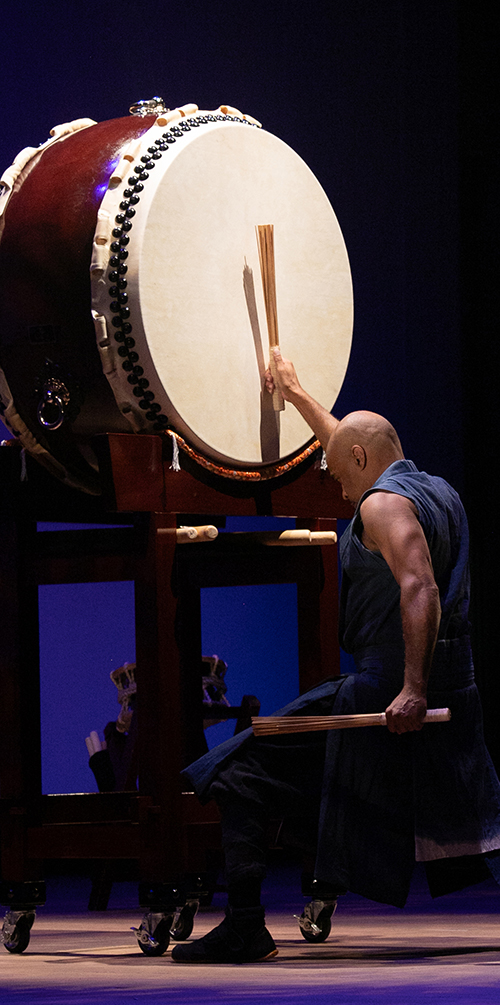|
Silk Road
**Written by Art Lee**
The new opening piece of Wadaiko TOKARA. This piece was created to be very
different from usual taiko pieces, and is constructed with many different rhythms similar
to Indian, African and Korean traditional percussive style. It also employs various time signatures including 3, 5, 7 and 9 counts.
Silk Road follows a mythical journey of the taiko as it was created in the African continent and evolved as it moved through India, China, Korea and Japan.
Nagisa Monogatari
**Written by Art Lee**
This is the story of one person called "Nagisa"
who sits upon the beach sands for nearly an eternity, watching the world
through the reflections of the sea before him. From the calm of midnight,
to the climbing sun and building waves of midday. From the time of evening
when all go again their own ways, back to the calm of night once more.
MIZUKAGAMI
**Written by Art Lee**
Mizukagami is played on all shimedaiko (small drum with a high pitch) where
the left side players mirror the right, and inner players mirror the
outer players. The speed and intricacy of this piece was received with
thundering applause at its debut in Japan.
Sva (Vital Force)
**Music by Art Lee/Dance by Ragamala**
A new work by Wadaiko Ensemble TOKARA and Ragamala Music and Dance Theater,
this collaboration between two culturally-based art forms— Japanese
Taiko and Bharatanatyam Dance —brings the driving percussion and
sweeping physicality of the drummers into conversation with the complex
rhythms and athletic precision of the dancers. Sva explores the kinships
between the two art forms and the Hindu and Shinto spiritual traditions
from which they emerge. The graceful melodies of Tokara Artistic Director
Art Lee on the shinobue flute, woven together with Carnatic (South Indian
classical) flute by V. K. Raman, augment the powerful rhythms of the
Taiko.
Chichibu Yatai Bayashi
**Traditional/arranged by Art Lee**
Originating in Chichibu, Saitama Prefecture, this
piece is played in a sitting position, simulating the posture needed
during various festivals in Japan. The player sits inside a small and
intricately carved float which is pulled and pushed very quickly by
nearly one hundred people. Depending upon the rhythms played, everyone
will know whether to turn left or right or to stop.
Kandou
**Written by Art Lee**
Starting out on a long road trip. Kandou signifies what lies between a very busy road, the calm in the eye of the storm, and how it can be easily forgotten
when caught up in the storm of that busy road.
Buchiawase Daiko
**Traditional**
In the south of Tokyo on the Miura Peninsula, "Buchiawase"
is played after a successful round of fishing. There is a contest. One Taiko-group plays the piece on the mountain in Minsaki,
the other group on the opposite mountain.
"Buchiawase" is usually played so powerfully and aggressively
that it is also called "Kenka Daiko", which means "The
Fighting Drums"
Miyake Daiko
**Traditional/arranged by Art Lee**
Around the island of Miyake, just off the coast of Tokyo,
the ocean caresses, slowly and smoothly, the outstretched land.
As the waters move away from the island, they begin to move
rapidly and gain strength as the wind and the ocean floor pushes
the waters upward and on, more powerfully until reaching the
mainland with full force.
Sansai
**Written by Matt Steitle**
Fire, Flood, Storm.
We know them. Fear, Chaos, Disaster
They are the same. They are Sansai.
The storm strikes with sudden unpredictability and deliberate intent,
tearing its way through the sky, sculpting the landscape in its own image.
From the belly of the beast, thunder growls like a demon and spits flames
down to earth to feed on the land and grow into a towering inferno. Rain
plummets from the heavens, an unstoppable army, and wind howls its battle
cry to the sea, rallying it to join the fray with its awesome power. They
exist together just as they vie for dominance. Then, just as a candle,
as the storm begins to burns its brightest, it is suddenly no more.
Hatou no Hibiki
**Written by Art Lee**
Who doesn't enjoy walking up and down the beach, listening
to the ocean and the birds, and that cute dog who just knocked you
over trying to get to his frisbee?
At the bottom of the beach, we can see the
Hatou where the water turns white as it's kicked up by sand and rock.
The name signifies the beauty and calm of the lapping waves, but the
piece itself takes you to a party...the one you can hear and see just
beneath those lapping waves as the rocks and sand bump each other.
Existension
**Written by Art Lee**
“Existension” is a combination of
the words “Existence” and “Extension”.
The continuation of the existence of the human race as a whole, regardless
of race or gender, is a necessity of the most basic of human instinct.
Yet, for many, it is not simply enough to just continue to exist,
but to grow...whether it be mentally, spiritually or in any other
manner. The ultimate goal of the human race must be to better ourselves...the
extension of our existence.
Kagiri
**Written by Art Lee and Matt Steitle**
"The fiery fog" is all around us.
It is what heats us up when we play.
It is what fires our intensity and keeps us focused.
It presses us to go on and on, and to never give up.
It augments our strength and gives us confidence.
It ignites our hearts and makes us dance.
The "Kagiri" is all around us.
Tonbane Daiko
**Written by Grandmaster Daihachi Oguchi**
"Tonbane" is a fairly new piece, but uses the same rhythms
as the well-known piece, "Isami Goma".
It was originally created and played by
GrandMaster Daihachi Oguchi and Osuwa Daiko.
Upon request from him for us to perform this piece during our U.S. tour,
we have arranged the piece so that both "Tonbane" and "Isami
Goma"
are played simultaneously.
|



